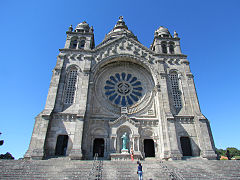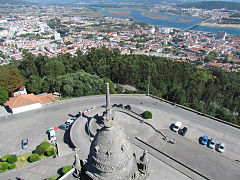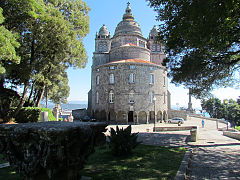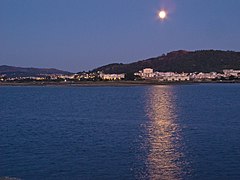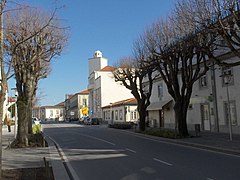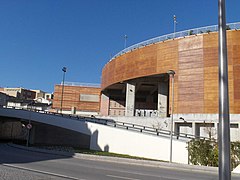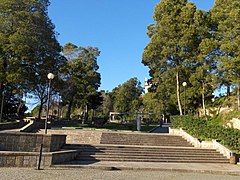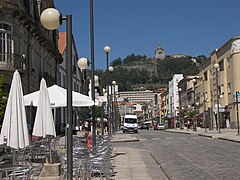Viana do Castelo
Viana do Castelo | |
|---|---|
Panoramic, Santa Lucia Church, Republic Square, Sé Cathedral, Fountain | |
 | |
| Coordinates: 41°42′N 8°50′W / 41.700°N 8.833°W | |
| Country | |
| Region | Norte |
| Intermunic. comm. | Alto Minho |
| District | Viana do Castelo |
| Government | |
| • President | Luís Nobre (PS) |
| Area | |
• Total | 319.02 km2 (123.17 sq mi) |
| Elevation | 12 m (39 ft) |
| Highest elevation | 825 m (2,707 ft) |
| Lowest elevation | 0 m (0 ft) |
| Population (2021) | |
• Total | 85,778 |
| • Density | 270/km2 (700/sq mi) |
| Time zone | UTC+00:00 (WET) |
| • Summer (DST) | UTC+01:00 (WEST) |
| Postal code | 4900 |
| Area code | 258 |
| Patron | Nossa Senhora da Agonia |
| Website | www |
Viana do Castelo (European Portuguese pronunciation: [viˈɐnɐ ðu kɐʃˈtɛlu] ⓘ) is a municipality and seat of the district of Viana do Castelo in the Norte Region of Portugal. The population in 2021 was 85,778,[1] in an area of 319.02 square kilometres (123.17 sq mi).[2] The urbanized area of the municipality, comprising the city, has a population of approximately 36,148 inhabitants, although the extended densely populated region reaches surrounding municipalities like Caminha and Ponte de Lima with a population above 150,000 inhabitants. It is located at the mouth of the Lima river, on the Portuguese Way path, an alternative path of the Camino de Santiago.
History
[edit]Human settlement in the region of Viana began during the Mesolithic era, from discoveries and archaeological excavations. Settlements in the Mount of Santa Luzia date back to the Iron age, extending into the Roman occupation the area.[3]
The settlement of Viana da Foz do Lima, which it was called when King Afonso III of Portugal issued a foral (charter) on 18 July 1258, was a formalization of the 1253 Viana that the area was named.[3]
The port in Viana do Castelo played an important role in the city's development. In the 15th century, it was on the trade routes between the Mediterranean and the North Atlantic, when textiles, fruits, wood and iron were headed south while salt and agricultural products were northbound.[4] In 1455, a cathedral was inaugurated in Viana do Castelo.[5] During the later part of the century, the city became an important supplier of textiles to the newly established colonies in Madeira and the Azores.[4]
However, the port's importance grew substantially from the 16th century, during the age of discoveries, when the sugar trade from Brazil emerges in Viana. Merchants from Northern Europe establish themselves in the city, trading in sugar and selling bread from the Baltic. In parallel, the fishing industry developed, due to cod fishing off the coast of Newfoundland and Greenland, an important foodstuff for cross Atlantic voyages.[4][6]
During this period of prosperity, a number of religious institutions installed themselves in the city and a via sacra (sacred way) was created, through the city's northern edge.[4][7] In 1576, a Dominican convent and church is inaugurated to São Domingos (St. Dominic), designed by monk Julião Romero. In 1612, a Franciscan convent to St. Anthony was founded to the north of the city by the Order of Friars Minor.[8] The parish of Nossa Senhora de Monserrate (Our Lady of Monserrat) was founded in 1621 next to the old barracks named Batalhão de Caçadores 9.[9][10] In 1627 a decision was taken to establish a monastery of the Order of Saint Augustine to St. Theotonius. The monastery was inaugurated in 1630, but construction work continued for several years.[11] In 1678, a chapel was built to the Holy Sepulchre, which by 1744 had originated a Marian devotion to Nossa Senhora da Agonia (Our Lady of Agony), a large worship figure in Viana, especially among fishermen.[7]
Viana do Castelo had coastal defenses on its western side, at the mouth of the river since the reign of Alfonso III in the 13th century. During the 15th century, these would be upgraded, including Torre da Roqueta (tower of Roqueta), to protect from pirates. In the 16th century, defenses were again boosted, to protect the prosperous city, with the start of the construction of Fort Santiago da Barra.[12]
After the maritime discoveries and trade, the commercial life of Viana reached its greatest proportions during the reign of Queen Maria II of Portugal, when the monarch established the Associação Comercial de Viana do Castelo in 1852 (the fourth oldest public company of its type). The queen, in order to reward the loyalty of its citizens, who did not surrender to the Count of Antas, elevated the town to the status of city on 20 January 1848, renaming the settlement with its current name.
In 1878, the railway line Linha do Minho reached Viana do Castelo connecting it to Porto to the south. The railway crossed the Lima river on a new railway bridge, Ponte Eiffel, designed by Gustave Eiffel. In 1882, the line was completed, reaching the border with Spain to the north and Viana's railway station was completed. During the construction process, the monastery of the Order of Saint Augustine was demolished to make way for the project and much of its stonework was repurposed for viaducts and the station building.[11]
In 1884, the veneration of Santa Luzia (St. Lucy) strengthened after a cavalry commander Luis de Andrade e Sousa founded the Confraternity of Santa Luzia. It was founded after his poor eyesight improved following two years visiting a chapel atop the mountain of Santa Luzia. The confraternity improved the state of the chapel and its accessibility.[13]
In 1904, construction started on the Sanctuary of the Sacred Heart of Jesus, commonly referred to as the church or sanctuary of Santa Luzia, on top of the mountain of Santa Luzia. Construction on its exterior ended in 1943, but works continue on its interior until 1959. The cult in Viana do Castelo dates back to 1743, but it grew in popularity during a pandemic in 1918. In 1926, the chapel of Santa Luzia would be demolished and its image transferred to the sanctuary.[14]
Geography
[edit]
| ||||||||||||||||||||||||||||||||||||||||||||||||||||||
Administratively, the municipality is divided into 27 civil parishes (freguesias):[20]
- Afife
- Alvarães
- Amonde
- Anha
- Areosa
- Barroselas e Carvoeiro
- Cardielos e Serreleis
- Carreço
- Castelo do Neiva
- Chafé
- Darque
- Freixieiro de Soutelo
- Geraz do Lima (Santa Maria, Santa Leocádia e Moreira) e Deão
- Lanheses
- Mazarefes e Vila Fria
- Montaria
- Mujães
- Nogueira, Meixedo e Vilar de Murteda
- Outeiro
- Perre
- Santa Marta de Portuzelo
- São Romão de Neiva
- Subportela, Deocriste e Portela Susã
- Torre e Vila Mou
- Viana do Castelo (Santa Maria Maior e Monserrate) e Meadela
- Vila de Punhe
- Vila Franca
Climate
[edit]Viana do Castelo has a warm-summer Mediterranean climate (Köppen: Csb; Thornthwaite: ArB'2a')[21] with substantial oceanic influences characterized by warm, relatively dry summers and mild, rainy winters. It is also one of the rainiest cities in Continental Portugal.
Temperatures above 30 °C are relatively rare during summertime, happening on about 20 days per year on average; while in the cold months there are on average 29 days with frost.[22]
| Climate data for Viana do Castelo (Meadela) | |||||||||||||
|---|---|---|---|---|---|---|---|---|---|---|---|---|---|
| Month | Jan | Feb | Mar | Apr | May | Jun | Jul | Aug | Sep | Oct | Nov | Dec | Year |
| Record high °C (°F) | 24.0 (75.2) |
25.0 (77.0) |
30.5 (86.9) |
31.6 (88.9) |
35.6 (96.1) |
38.6 (101.5) |
38.0 (100.4) |
39.5 (103.1) |
36.4 (97.5) |
32.6 (90.7) |
26.2 (79.2) |
24.6 (76.3) |
39.5 (103.1) |
| Mean daily maximum °C (°F) | 14.6 (58.3) |
15.5 (59.9) |
17.9 (64.2) |
18.5 (65.3) |
20.7 (69.3) |
24.5 (76.1) |
26.3 (79.3) |
26.4 (79.5) |
24.8 (76.6) |
20.9 (69.6) |
17.4 (63.3) |
15.2 (59.4) |
20.2 (68.4) |
| Daily mean °C (°F) | 9.8 (49.6) |
10.5 (50.9) |
12.7 (54.9) |
13.7 (56.7) |
15.9 (60.6) |
19.2 (66.6) |
20.8 (69.4) |
20.8 (69.4) |
19.2 (66.6) |
16.1 (61.0) |
12.8 (55.0) |
10.8 (51.4) |
15.2 (59.3) |
| Mean daily minimum °C (°F) | 4.9 (40.8) |
5.5 (41.9) |
7.4 (45.3) |
8.8 (47.8) |
11.1 (52.0) |
13.9 (57.0) |
15.3 (59.5) |
15.1 (59.2) |
13.7 (56.7) |
11.2 (52.2) |
8.1 (46.6) |
6.4 (43.5) |
10.1 (50.2) |
| Record low °C (°F) | −3.9 (25.0) |
−2.8 (27.0) |
−3.7 (25.3) |
−0.4 (31.3) |
0.8 (33.4) |
5.5 (41.9) |
9.0 (48.2) |
8.0 (46.4) |
7.0 (44.6) |
2.4 (36.3) |
−1.2 (29.8) |
−5.1 (22.8) |
−5.1 (22.8) |
| Average rainfall mm (inches) | 189.9 (7.48) |
168.0 (6.61) |
105.3 (4.15) |
117.7 (4.63) |
105.5 (4.15) |
56.1 (2.21) |
28.4 (1.12) |
30.6 (1.20) |
95.7 (3.77) |
163.9 (6.45) |
180.8 (7.12) |
228.3 (8.99) |
1,470.2 (57.88) |
| Average rainy days (≥ 0.1 mm) | 16.3 | 15.0 | 13.9 | 15.3 | 14.5 | 9.2 | 6.6 | 6.5 | 9.0 | 15.0 | 15.0 | 17.3 | 153.6 |
| Mean monthly sunshine hours | 127.9 | 130.0 | 182.5 | 206.9 | 234.7 | 270.6 | 300.5 | 285.9 | 211.8 | 167.0 | 136.5 | 114.9 | 2,369.2 |
| Source: Instituto de Meteorologia[23][22] (1981-2010 temperature normals, 1971-2000 precipitation and sunshine hours) | |||||||||||||
Economy
[edit]Home to a modern service based economy, the city, along with its region, has a seaport with naval repairing facilities. Its major industries are related to naval construction and repair, with the Estaleiros da Viana do Castelo remaining one of the few large shipyards still in operation. Home to a large cluster of wind green electricity and car-parts industries it has become one of the most dynamic exporting regions in the country.
Architecture
[edit]


Civic
[edit]Since the early 1990s the city started a wide urban renewal plan, pioneering the "Polis program", and including enlarging the pedestrian areas, building new modern architecture and creating new public spaces and parks. Architects such as Siza Vieira, Eduardo Souto de Moura and Fernando Távora have participated in the construction of a modern, well preserved and lively city center.
- Geraz do Lima carriage museum
- Renaissance fountain (1535) in the Major Square
- Palacio de Tavoras, a noble residence from the 16th and 17th centuries
- Municipal Museum, housed in an 18th-century building and home to
- Paços do Conselho ("Palace of the Council", 1502), of which only the façade remains today
Religious
[edit]- Church of São Domingos (1576)
- Chapel of the Holy Family (Portuguese: Capela da Sagrada Família e Portal da Quinta dos Espregueira)
- Chapel of Our Lady of the Agony (Portuguese: Capela de Nossa Senhora da Agonia), church in Roccoco style
- Cathedral of Viana do Castelo (Portuguese: Igreja Matriz de Viana do Castelo/Catedral de Viana do Castelo/Sé de Viana do Castelo), the 15th-century parochial church and cathedral, was constructed in the Romanesque style, comprising a façade flanked by two large towers with merlons, while the middle Gothic portal with archivolts is decorated by sculptures depicting the Passion of Christ and of the Apostles. The interior designed in the form of the Latin cross, includes a nave and two aisles (separated by arches supported by pillars), as well as two ancillary chapels dedicated to São Bernardo and the Holy Sacrament, both attributed to João Lopes "the Elder".
- Church of Mercy of Viana do Castelo (Portuguese: Igreja da Misericórdia de Viana do Castelo), designed in the Flemish-style. The building dates back to 1589.
- Sanctuary of Saint Lucy (Portuguese: Santuário de Santa Luzia), designed by Miguel Ventura Terra and dedicated to the cult of the Sacred Heart of Jesus and Saint Lucy of Syracuse.
Culture
[edit]
The Festa de Nossa Senhora d'Agonia (Festivity of Our Lady of Agony), is held in Viana do Castelo and it is one of Portugal's largest and oldest religious festivals. The event spans several days and includes a wide variety of activities, both religious and secular. These range from processions and ethnographic parades to performances featuring music, traditional dances, and large figures such as "cabeçudos" and "gigantones". Other attractions include a craft fair, fireworks displays, and musical concerts. The festivity has become an important cultural and economic event, stimulating tourism and local commerce.[24]
Since 1985 the Teatro Sá de Miranda has been owned by the municipality, which has restored it to its former glory as one of the leading theatres in the provinces of Portugal.[25][26] Viana do Castelo has the headquarters of Portugal's second oldest newspaper, A Aurora do Lima.[27]
Viana do Castelo is renowned for its traditional pastries, such as the sidónio and the Torta de Viana. The sidónio, an almond-flavored pastry shaped like a coffin, is closely associated with the city's oldest bakery, Pastelaria Brasileira. Its name and design pay homage to Sidónio Pais, a prominent Portuguese statesman. The Torta de Viana, also known as Torta Real, is a sweet with origins dating back to 1505, linked to the Convent of Santa Ana in Viana do Castelo. It was historically reserved for special occasions and is recognized today as an iconic symbol of the city’s gastronomy. It was certified in 2021 to ensure adherence to its original recipe.[28][29]
Sport
[edit]SC Vianense is the local football club. Founded in 1898, it is one of the oldest clubs in Portugal. They play their home matches at the 3000 capacity Estádio do Dr. José de Matos.
Notable people
[edit]
- Sofia Aparício (born 1970) a Portuguese model and actress.
- Pedro Manuel de Ataíde (1665–1722) an army officer and nobleman
- Luís do Rego Barreto (1777–1840) 1st Viscount of Geraz do Lima, a military officer and colonial administrator
- Caramuru (ca.1475-1557) helped the early colonization of Brazil by the Portuguese crown.
- Tânia Carvalho (born 1976) a choreographer and works in music, drawing and film.
- Joe Duarte (born 1941) a politician and former Republican member of the New Hampshire House of Representatives
- João Álvares Fagundes (ca.1460–1522) ship owner, explored Newfoundland & Nova Scotia.
- Óscar de Lemos (1906–1954) a Portuguese stage and film actor
- Sebastião Lopes de Calheiros e Meneses (1816–1899) a colonial administrator of Cape Verde and Angola.
- Paulo de Morais (born 1963) a professor and politician
- Francisco de Sá Noronha (1820–1881) a composer and violinist
- Luís Miguel Rocha (1976–2015) author, television writer and producer.
- Olga Roriz (born 1955) a dancer and choreographer
- João de Sousa (1666–1722) 3rd Marquis of Minas, nobleman and the 6th Count of Prado.
- Adriana de Vecchi (1896–1995) a cellist, Montessori-trained educator and founder of a Lisbon music school for children
Sport
[edit]
- Jordão Cardoso (born 1996) a footballer
- Miguel Crespo (born 1996) a footballer
- Mário Felgueiras (born 1986) a former footballer
- César Fonte (born 1986) a cyclist
- Rogério Gonçalves (born 1959) a football manager
- Rui Lavarinhas (born 1971) a former cyclist
- Iúri Leitão (born 1998) a Portuguese road and track cyclist
- Nélson Lenho (born 1984) a former footballer with 358 club caps
- Manuela Machado (born 1963) a former long-distance runner
- Tiago Mendes (born 1981) a football manager and former player with 457 club caps and 66 for Portugal
- Martim Neto (born 2003) a footballer
- Pedro Neto (born 2000) footballer for Chelsea FC with 4 caps for Portugal
- Vânia Neves (born 1990) a swimmer
- João Queirós (born 1998) a footballer playing in the Armenian Premier League
- Rui Rêgo (born 1980) a former football goalkeeper with 538 club caps.
- Rodrigo Ribeiro (born 2005) a footballer
- Nuno Santos (born 1980) a former footballer with 389 club caps
- Chico Silva (born 1967) a former footballer who played for S.C. Braga
- Tomás Silva (born 1999) a footballer
- Analídia Torre (born 1976) a former long-distance runner, specialized in cross-country running.
- Francisco Trincão (born 1999) footballer for Sporting CP with 7 caps for Portugal
International relations
[edit]Viana do Castelo is twinned with:[30]
 Alagoas, Brazil
Alagoas, Brazil Aveiro, Portugal
Aveiro, Portugal Cabedelo, Brazil
Cabedelo, Brazil Hendaye, France
Hendaye, France Igarassu, Brazil
Igarassu, Brazil Itajaí, Brazil
Itajaí, Brazil Lancaster, England
Lancaster, England Lugo, Spain
Lugo, Spain Matola, Mozambique
Matola, Mozambique Pessac, France
Pessac, France Porto Seguro, Brazil
Porto Seguro, Brazil Ribeira Grande, Cape Verde
Ribeira Grande, Cape Verde Rio de Janeiro, Brazil
Rio de Janeiro, Brazil Riom, France
Riom, France Viana, Brazil
Viana, Brazil
Gallery
[edit]-
Sanctuary of the Sacred Heart of Jesus
-
City view from the top of the sanctuary of the Sacred Heart of Jesus
-
Sanctuary of the Sacred Heart of Jesus
-
Monument to the 25th of April
-
Viana do Castelo, Portugal
-
Viana do Castelo, Portugal
-
Viana do Castelo, Portugal
-
Viana do Castelo, Portugal
-
Viana do Castelo, Portugal
-
Avenida dos Combatentes da Grande Guerra (Avenue of Combatants of the Great War)
-
Avenida dos Combatentes da Grande Guerra (Avenue of Combatants of the Great War)
-
Avenida dos Combatentes da Grande Guerra (Avenue of Combatants of the Great War)
-
Avenida dos Combatentes da Grande Guerra (Avenue of Combatants of the Great War)
-
Viana do Castelo, Portugal
References
[edit]- ^ a b INE (2021). "Censos". Instituto Nacional de Estatística. Retrieved 22 November 2024.
- ^ "Áreas das freguesias, concelhos, distritos e país". Archived from the original on 5 November 2018. Retrieved 5 November 2018.
- ^ a b "Viver". Câmara Municipal de Viana do Castelo (in European Portuguese). Retrieved 22 August 2024.
- ^ a b c d Moreira, Manuel Antônio Fernandes (2002). "О porto de Viana do Castelo na Epoca dos Descobrimentos" (PDF). O Litoral em Perspectiva Histórica (Séculos XVI a XVIII): Um ponto da situação historiográfica.
- ^ "Sé Catedral de Viana do Castelo | www.visitportugal.com". www.visitportugal.com. Retrieved 22 August 2024.
- ^ Faria Viana, Rui Alberto (2022). "The port of Viana do Castelo across the ages". Portus.
- ^ a b Abreu, Alberto A. (1994). "A devoção vianense a Nossa Senhora da Agonia". Theologica. 29 (2): 343 345 346.
- ^ "Convento de Santo António de Viana do Castelo - Arquivo Nacional da Torre do Tombo - DigitArq". digitarq.arquivos.pt. Retrieved 22 August 2024.
- ^ "História:: Pmcomunicacao". www.paroquiamonserrate.com (in Portuguese). 26 April 2023. Retrieved 19 August 2024.
- ^ "Batalhão caçadores 9 (BC9)". curiosidadesdeviana.blogs.sapo.pt. Retrieved 19 August 2024.
- ^ a b Ribeiro T. de Pinho, Isabel Maria (2007). "Os crúzios de Viana do Castelo e a sua expressão artística" (PDF). Revista da Faculdade de Letras. 6 (1).
- ^ Viana Correia, Jorge Alexandre (2011). "As defesas litorais de Viana do Castelo durante o século XVI" (PDF).
- ^ "Confraria | Confraria de Santa Luzia | Monumento Viana Castelo". templosantaluzia.org. Retrieved 19 August 2024.
- ^ "Santuário | Confraria de Santa Luzia | Monumento Viana Castelo". templosantaluzia.org. Retrieved 19 August 2024.
- ^ INE (2001). "Censos". Instituto Nacional de Estatística. Retrieved 22 November 2024.
- ^ INE (1996). "Região do Norte". Censos 1991. XIII Recenseamento Geral da População. III Recenseamento Geral da Habitação. Resultados definitivos [Census 1991. XIII General Population Census. III General Housing Census. Definitive results.] (in European Portuguese). Lisbon. p. 42. Retrieved 22 November 2024.
{{cite book}}: CS1 maint: location missing publisher (link) - ^ INE (1984). "Distrito de Viana do Castelo". XII Recenseamento Geral da População. II Recenseamento Geral da Habitação. Resultados definitivos: 1981 [XII General Population Census. II General Housing Census. Definitive Results: 1981] (in European Portuguese). Lisbon. p. 5. Retrieved 22 November 2024.
{{cite book}}: CS1 maint: location missing publisher (link) - ^ INE (1971). "1º Volume". 11º Recenseamento da População. 1º Recenseamento da Habitação: continente e ilhas: 1970 [11th Population Census. 1st Housing Census: mainland and islands: 1970] (in European Portuguese). Lisbon. p. 63. Retrieved 22 November 2024.
{{cite book}}: CS1 maint: location missing publisher (link) - ^ INE (1964). "Tomo I Volume 1º". X Recenseamento Geral da População no continente e ilhas adjacentes às 0 horas de 15 de Dezembro de 1960 [10th General Population Census in the mainland and adjacent islands as of 12:00 AM on December 15, 1960] (in European Portuguese). Lisbon. p. 93. Retrieved 22 November 2024.
{{cite book}}: CS1 maint: location missing publisher (link) - ^ Diário da República. "Law nr. 11-A/2013, pages 552 127-128" (PDF) (in Portuguese). Retrieved 4 August 2014.
- ^ "Plano de Gestão da Região Hidrográfica do Minho e Lima" (PDF). apambiente.pt. p. 151. Retrieved 18 October 2021.
- ^ a b "Climate Normals - Viana do Castelo 1971-2000" (PDF). Portuguese Institute of Meteorology. Retrieved 14 September 2020.
- ^ "Climate Normals - Viana do Castelo 1981-2010". Portuguese Institute of Meteorology. Retrieved 11 February 2016.
- ^ Moura, Anabela; Moura, João; Cardoso, António; Escaleira, Joaquim; Almeida, Carlos (18 June 2024). "Festa Nossa Senhora d'Agonia: contributo para a análise do impacto sociocultural, ambiental e económico na sub-região do Alto Minho (Portugal)". Revista Evidência (in Portuguese). 11 (0). ISSN 2966-1412.
- ^ Sousa Bastos, António de (1908). Diccionario do Theatro Portuguez (PDF). Imprensa Libanio da Silva. p. 361. Retrieved 23 September 2024.
- ^ "História". Teatro Municipal Sá de Miranda. Retrieved 23 September 2024.
- ^ "Viana do Castelo compra por 170 mil euros espólio de 2.º jornal mais antigo do país". O Minho (in European Portuguese). 29 April 2021. Retrieved 23 November 2024.
- ^ SAPO. "Viana do Castelo: os sidónios da pastelaria Brasileira". SAPO Viagens (in Portuguese). Retrieved 23 November 2024.
- ^ "Receita original da Torta de Viana estará em dez pastelarias". Jornal de Notícias (in Portuguese). Retrieved 23 November 2024.
- ^ "Relações internacionais / cooperação". cm-viana-castelo.pt (in Portuguese). Viana do Castelo. Retrieved 10 December 2019.









